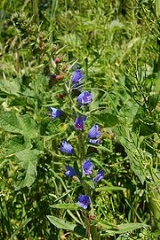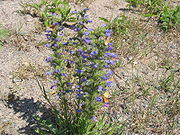
Viper's Bugloss
Encyclopedia
Echium vulgare is a species of Echium
native to most of Europe
, and western and central Asia
. It is also common in North America
.

 It is a biennial
It is a biennial
or monocarpic
perennial plant
growing to 30 – tall, with rough, hairy, lanceolate leaves
. The flower
s start pink and turn vivid blue and are 15 millimetre in a branched spike, with all the stamen
s protruding. Stamens remain red and stand out against the blue flowers. It flowers between May and September. It is found in dry, bare and waste places.
It has been introduced to North America
and is naturalised
in parts of the continent, being listed as an invasive species
in Washington.
Echium is grown as an oilseed crop because of the fatty acid
composition of the seed oil. Like borage
and evening primrose oil, it contains significant amounts of gamma linolenic acid (GLA), but it also contains the rarer stearidonic acid
(SdA).
Echium
Echium is a genus of 60 species of flowering plant in the family Boraginaceae.The type species is Echium vulgare, viper's bugloss. Species of Echium are native to North Africa, Europe, Madeira and the Canary Islands, but have also become invasive in southern Africa and Australia...
native to most of Europe
Europe
Europe is, by convention, one of the world's seven continents. Comprising the westernmost peninsula of Eurasia, Europe is generally 'divided' from Asia to its east by the watershed divides of the Ural and Caucasus Mountains, the Ural River, the Caspian and Black Seas, and the waterways connecting...
, and western and central Asia
Asia
Asia is the world's largest and most populous continent, located primarily in the eastern and northern hemispheres. It covers 8.7% of the Earth's total surface area and with approximately 3.879 billion people, it hosts 60% of the world's current human population...
. It is also common in North America
North America
North America is a continent wholly within the Northern Hemisphere and almost wholly within the Western Hemisphere. It is also considered a northern subcontinent of the Americas...
.


Biennial plant
A biennial plant is a flowering plant that takes two years to complete its biological lifecycle. In the first year the plant grows leaves, stems, and roots , then it enters a period of dormancy over the colder months. Usually the stem remains very short and the leaves are low to the ground, forming...
or monocarpic
Monocarpic
Monocarpic plants are those that flower, set seeds and then die. Other terms with the same meaning are hapaxanth and semelparous. The term was first used by Alphonse de Candolle....
perennial plant
Perennial plant
A perennial plant or simply perennial is a plant that lives for more than two years. The term is often used to differentiate a plant from shorter lived annuals and biennials. The term is sometimes misused by commercial gardeners or horticulturalists to describe only herbaceous perennials...
growing to 30 – tall, with rough, hairy, lanceolate leaves
Leaf
A leaf is an organ of a vascular plant, as defined in botanical terms, and in particular in plant morphology. Foliage is a mass noun that refers to leaves as a feature of plants....
. The flower
Flower
A flower, sometimes known as a bloom or blossom, is the reproductive structure found in flowering plants . The biological function of a flower is to effect reproduction, usually by providing a mechanism for the union of sperm with eggs...
s start pink and turn vivid blue and are 15 millimetre in a branched spike, with all the stamen
Stamen
The stamen is the pollen producing reproductive organ of a flower...
s protruding. Stamens remain red and stand out against the blue flowers. It flowers between May and September. It is found in dry, bare and waste places.
It has been introduced to North America
North America
North America is a continent wholly within the Northern Hemisphere and almost wholly within the Western Hemisphere. It is also considered a northern subcontinent of the Americas...
and is naturalised
Naturalisation (biology)
In biology, naturalisation is any process by which a non-native organism spreads into the wild and its reproduction is sufficient to maintain its population. Such populations are said to be naturalised....
in parts of the continent, being listed as an invasive species
Invasive species
"Invasive species", or invasive exotics, is a nomenclature term and categorization phrase used for flora and fauna, and for specific restoration-preservation processes in native habitats, with several definitions....
in Washington.
Echium is grown as an oilseed crop because of the fatty acid
Fatty acid
In chemistry, especially biochemistry, a fatty acid is a carboxylic acid with a long unbranched aliphatic tail , which is either saturated or unsaturated. Most naturally occurring fatty acids have a chain of an even number of carbon atoms, from 4 to 28. Fatty acids are usually derived from...
composition of the seed oil. Like borage
Borage
Borage, , also known as a starflower, is an annual herb originating in Syria, but naturalized throughout the Mediterranean region, as well as Asia Minor, Europe, North Africa, and South America. It grows to a height of , and is bristly or hairy all over the stems and leaves; the leaves are...
and evening primrose oil, it contains significant amounts of gamma linolenic acid (GLA), but it also contains the rarer stearidonic acid
Stearidonic acid
Stearidonic acid is an ω-3 fatty acid, sometimes called moroctic acid. It is biosynthesized from alpha-linolenic acid by the enzyme delta-6-desaturase. Natural sources of this fatty acid are the seed oils of hemp, blackcurrant, corn gromwell and echium, and the cyanobacterium Spirulina....
(SdA).

